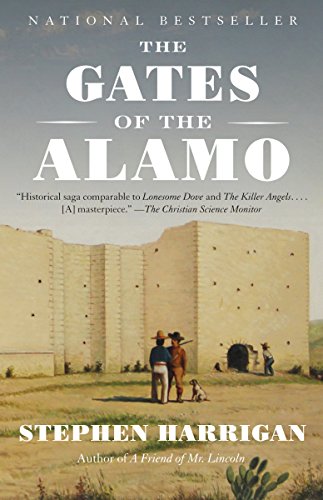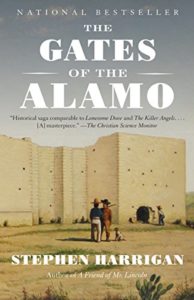Remembering–and Inventing–the Alamo

Historical novels can discomfit professional historians. It’s difficult enough keeping the source-based history straight. But novelists can invent dialogue, characters, events, venues, sequences, and certainly interpretations. Truth may be stranger, but fiction can be freer and more vivid, and let’s face it, more entertaining, at least in the hands of a skilled writer, and Stephen Harrigan certainly is that. I have often avoided historical novels for fear of sullying my accuracy, but I must admit to learning at least the basics about the Navajos from Tony Hillerman, about cowboys and Indians from James Michener and Larry McMurtry, about Gilded-Age New York from Henry James and Edith Wharton, and about the Napoleonic Wars from Leo Tolstoy. And I’ve had my classes read Willa Cather and William Dean Howells. Entertainment sugar coats didactic purpose, and we learn better what we enjoy.
For historians, perhaps the bottom line is whether one learns well or badly from a novel. Is Harrigan’s The Gates of the Alamo a good teacher about Texas in the mid-1830s? Beyond that, is it any fun, or to any purpose, to read again about the Alamo? Will we find here a “new gray story,” as Richard Etulain observes, is under construction all across the historiographic West? 1
As the historian Richard White once wrote, the two most celebrated mythopoeic battles in our history have been the Alamo and Little Big Horn, and both were defeats for the Anglo side, celebrated later because they legitimated retribution and vengeance. The Alamo was avenged a few weeks later at San Jacinto, and Custer’s defeat by the surrender of Sitting Bull and the relegation of the Lakota to reservations. So goes the triumphalist history. But there are other possible versions. The film Dances with Wolvesreversed the hero/victim roles between the army and the Indians, if rather too sweepingly. Stephen Harrigan’s novel does no such complete reversal–it hardly glorifies the Mexican caudillo Antonio López de Santa Anna–but it is a far cry from traditional Texan hagiography.
Here, the bronze-statue heroes of the Alamo become human. The legendary frontiersman Jim Bowie is seldom sober, and by the time of the siege he is too sick and delirious with typhoid to hold his eponymous knife; he is nursed by two elderly women from the Veramendi family of San Antonio aristocrats into which he had married. Twenty-seven-year-old William Travis, commander of the “regular” Texan forces, is a “complex, compelling, dangerous young man” (118), a hammer-headed hotspur who refuses to parley his way out of a hopeless situation; and Harrigan will have no truck with the legend that Travis drew a line in the sand, over which no defender jumped to escape. Joe, Travis’s black slave, understands that the Mexicans would free him, and he nearly makes a break, but is smothered by circumstances. His viewpoint, and the questions Harrigan raises through this character–above all, whether the Mexicans might have engendered a slave revolt in Anglo-Texas to possibly thwart the independence movement–invite fascinating speculation. Sam Houston, the soon-to-be first president of the Texas Republic, who was not at the Alamo, plays no great role in Harrigan’s story. But one glimpses enough of him to get the idea that his behavior was calculated: he either vacillated out of fear of defeat, or held back so as to enhance his own position among the Anglo-Texans. David Crockett is drawn as a natural leader, more Jacksonian than his by-then enemy Jackson, actually leaving the fortress to seek reinforcements but returning there to die. Harrigan explicitly rejects the account of José Enrique de la Peña that Crockett escaped but was caught and executed by Santa Anna. 2 He does employ another recently discovered Mexican source that has some dozens of defenders escaping and saving themselves, rather than staying and dying “to the last man.” On the Mexican side, Coronel Juan Almonte mitigates some of Santa Anna’s cruelest orders and appears as a merciful and intelligent officer and gentleman.
“Harrigan’s fictional characters, around whom develop most of the action, the romantic interests, the plain-to-squalid living conditions, and the Mexican-Anglo interactions, are more extensively drawn than the historic figures.”
Harrigan’s fictional characters, around whom develop most of the action, the romantic interests, the plain-to-squalid living conditions, and the Mexican-Anglo interactions, are more extensively drawn than the historic figures. Teniente Telesforo Villaseñor, who is co-opted by Santa Anna as a mapmaker and loyal adviser–Santa Anna sees directly through to the young man’s seething ambition–is an uncommon mixture of talent and, in a crucial moment, of subservient ruthlessness. The protagonists who carry much of the story are Irish Texans. James McGowan is a naturalist who has spent years botanizing in Texas until the conflict envelops him. Harrigan even has President Santa Anna, trying to run a bankrupt government in Mexico City, commissioning McGowan to investigate Yucatan chicle for its commercial chewing gum potential. (McGowan reminds me of the real Juan Pedro Walker, who like McGowan was once employed as a border surveyor by the United States, and when stiffed out of his compensation by Congress became a Mexican citizen–though Walker was active a decade or two earlier than the Alamo episode. 3) Mary Mott, the “female lead,” runs an inn near Refugio, there meeting Bowie and other historical figures. She and others in Refugio, Irish Catholics and Protestants, see Santa Anna’s Mexico as an oppressor on the English model. The San Patricio Irish settlers were, in fact, pulled both ways.
Harrigan’s description of the northward march of Santa Anna’s army is excellent and instructive. He makes clear its desperate lack of supplies, its near decimation by a blizzard, and its unreadiness to prevent Texan independence except when, as in the case of the Alamo, the Anglo rebels choose an insecure and undermanned place from which to fight. From Harrigan’s account of the Mexican army’s northward scramble, together with Santa Anna’s leadership flaws and the book’s no-punches-pulled portrayal of many Anglos’ contempt for Mexicans, their country, their religion, and their rejection of African slavery, the reader can construct a reasonable understanding of the Texans’ independence struggle from both sides–which, together with writing an engrossing yarn, is perhaps what Harrigan hoped to do. If so, he has succeeded very well.
Notes
1. Richard W. Etulain, Telling Western Stories: From Buffalo Bill to Larry McMurtry (Albuquerque, 1999).
2. On Crockett’s pre-Alamo career in congress, a fine recent account is Paul Andrew Hutton, “Mr. Crockett Goes to Washington,” American History (April 2000): 21-28. Hutton is presently completing a full-scale biography of Crockett.
3. On Walker, see Elizabeth A. H. John, “The Riddle of Mapmaker Juan Pedro Walker,” in Essays on the History of North American Discovery and Exploration, ed. Stanley H. Palmer and Dennis Reinhartz (College Station, Tex., 1988), 102-32.
This article originally appeared in issue 1.1 (September, 2000).
Walter Nugent is Professor of History at the University of Notre Dame and author of Into the West: The Story of Its People (New York, 1999).
